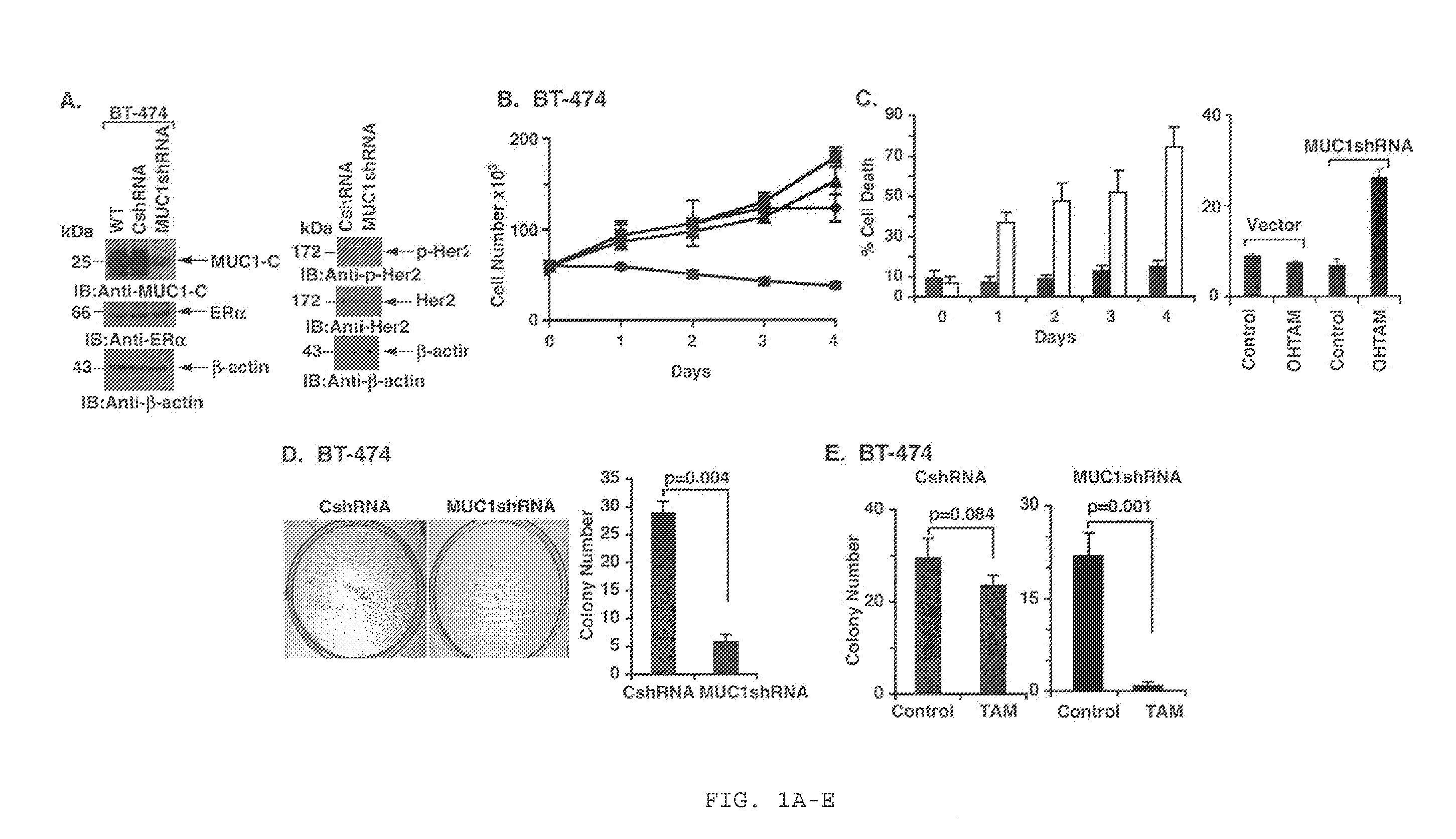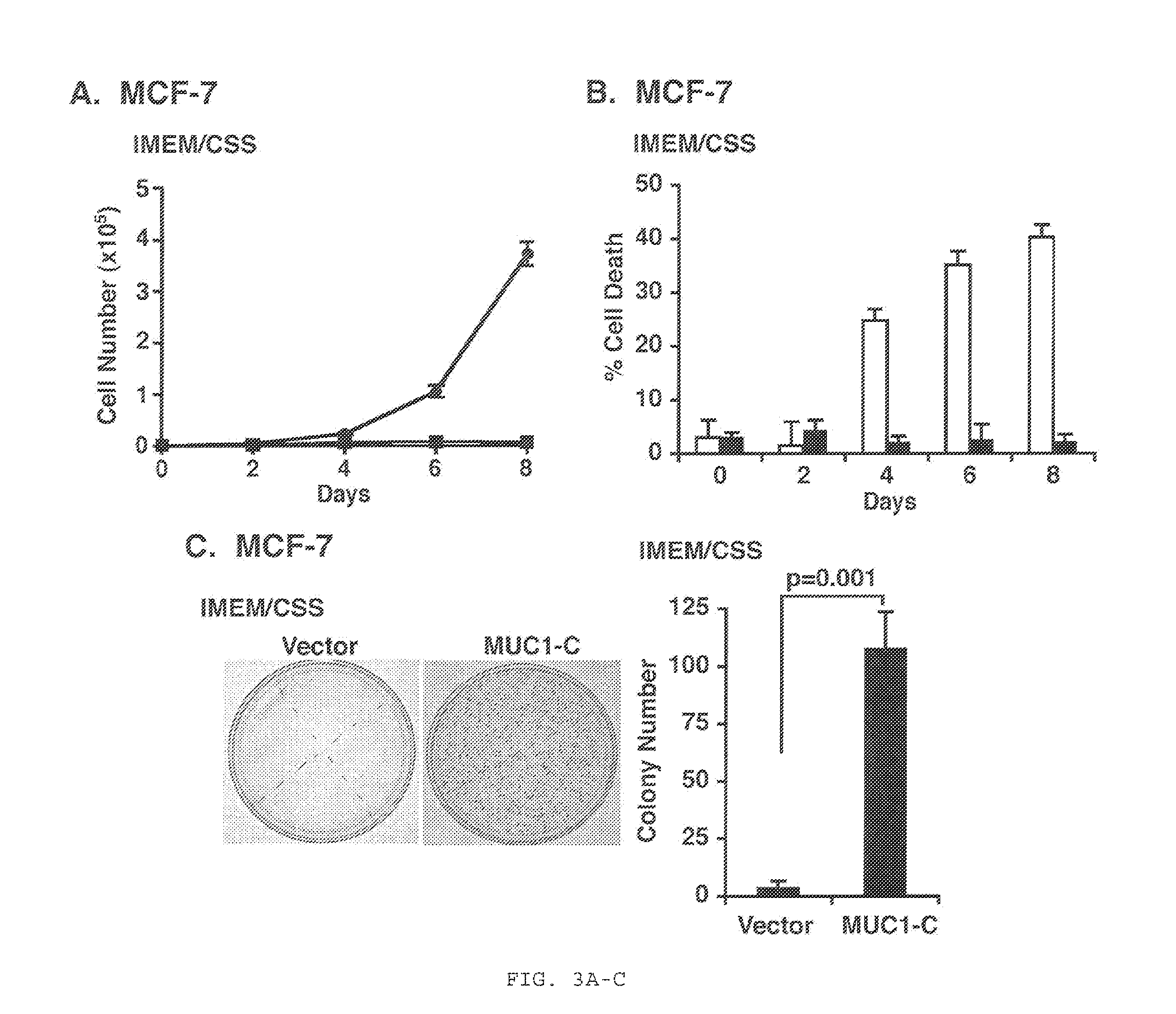Combination Anti-estrogen receptor cancer therapy using muc1 peptides and chemotherapeutics
a technology of er and peptides, applied in the field of cancer and medicine, can solve the problems of limited effectiveness and lack of direct evidence to date, and achieve the effect of reversing the resistance to said anti-er and improving the response ra
- Summary
- Abstract
- Description
- Claims
- Application Information
AI Technical Summary
Benefits of technology
Problems solved by technology
Method used
Image
Examples
example 1
Materials and Methods
[0105]Cell Culture.
[0106]Human HER2 overexpressing BT-474 breast cancer cells (ATCC) were grown in Dulbecco's Modified Eagle's Medium (DMEM) / Ham F12 medium (1:1 ratio), 10% heat-inactivated fetal bovine serum (HI-FBS), 100 μg / ml streptomycin, 100 units / ml penicillin and 2 mM L-glutamine. BT-474 cells were infected with lentiviral vector expressing a MUC1 shRNA (Sigma) or a scrambled control shRNA (CshRNA; Sigma). Human MCF-7 breast cancer and 293T renal cells (ATCC) were maintained in DMEM, 10% HI-FBS, antibiotics and L-glutamine. MCF-7 cells were transfected to stably express a control pHR-CMV-GFP vector or one expressing MUC1-C. For certain experiments performed in the absence of estrogen stimulation, cells were grown in phenol red-free Iscove's Modified Eagle's Medium (IMEM), 10% charcoal-stripped serum (CSS), antibiotics and L-glutamine. Cells were treated with tamoxifen (TAM; Sigma-Aldrich) or 4-hydroxytamoxifen (OHTAM; Sigma-Aldrich) dissolved in DMSO and,...
example 2
Results
[0117]Silencing MUC1-C Confers Sensitivity of BT-474 Cells to Tamoxifen Treatment.
[0118]BT-474 breast cancer cells overexpress HER2, are ER positive and are resistant to tamoxifen (Chung et al., 2002 and Ross-Innes et al., 2012). Immunoblot analysis further demonstrated that BT-474 cells express MUC1-C (FIG. 1A, left). To determine whether MUC1-C plays a role in tamoxifen resistance, the inventors transduced cells with a lentiviral vector expressing a control scrambled shRNA (CshRNA) or one expressing a MUC1 shRNA (FIG. 1A, left). Compared to wild-type (WT) BT-474 cells and those stably expressing the CshRNA, there was downregulation of MUC1-C in the cells expressing the MUC1 shRNA (FIG. 1A, left). As a control, the partial silencing of MUC1-C had little if any effect on ERα levels (FIG. 1A, left). MUC1 interacts with HER2 and promotes HER2-mediated signaling (Li et al., 2003c and Ren et al., 2006). In this context, partial silencing of MUC1-C in BT-474 cells was associated w...
example 3
Discussion
[0129]The overexpression of HER2 in breast cancers has been linked to tamoxifen resistance (De Laurentis et al., 2005). The present studies provide evidence that the MUC1-C oncoprotein promotes resistance to tamoxifen in the HER2 overexpressing BT-474 breast cancer cell model. Previous work had shown that MUC1-C forms a complex with HER2 and contributes to Heregulin-induced downstream signals (Ren et al., 2006; Yin and Kufe, 2003). In concert with those findings, silencing MUC1-C in BT-474 cells was associated with downregulation of p-HER2 levels. Moreover, silencing MUC1-C and thereby suppressing HER2 activation reversed the resistance of BT-474 cells to tamoxifen, consistent with cross-talk between HER2 signaling and the ER pathway. In further support of a role for MUC1-C in resistance of HER2-overexpressing BT-474 cells to tamoxifen, the inventors found that treatment with the MUC1-C inhibitor, GO-203, suppresses HER2 activation and confers sensitivity to tamoxifen-indu...
PUM
| Property | Measurement | Unit |
|---|---|---|
| delay time | aaaaa | aaaaa |
| delay time | aaaaa | aaaaa |
| delay time | aaaaa | aaaaa |
Abstract
Description
Claims
Application Information
 Login to View More
Login to View More - R&D
- Intellectual Property
- Life Sciences
- Materials
- Tech Scout
- Unparalleled Data Quality
- Higher Quality Content
- 60% Fewer Hallucinations
Browse by: Latest US Patents, China's latest patents, Technical Efficacy Thesaurus, Application Domain, Technology Topic, Popular Technical Reports.
© 2025 PatSnap. All rights reserved.Legal|Privacy policy|Modern Slavery Act Transparency Statement|Sitemap|About US| Contact US: help@patsnap.com



